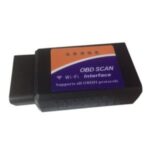Maintaining your Audi involves more than just regular servicing; understanding its diagnostic systems is key to proactive car care. Modern Audis, like most cars today, are equipped with an On-Board Diagnostics II (OBD2) system. This system monitors various aspects of your vehicle’s performance and can alert you to potential issues through diagnostic trouble codes (DTCs). Scanning your Audi using an OBD2 scanner is a straightforward process that empowers you to understand your car’s health and address problems early. This guide will walk you through how to effectively scan your Audi using an OBD2 scanner.
What You’ll Need to Scan Your Audi
Before you begin, you’ll need a couple of essential tools:
- An OBD2 Scanner: This is the core tool for accessing your Audi’s diagnostic system. OBD2 scanners come in various forms, from handheld devices to smartphone-based systems that utilize a Bluetooth or Wi-Fi adapter. For smartphone-based scanning, you’ll also need:
- An OBD2 Bluetooth or Wi-Fi Adapter: This adapter plugs into your Audi’s OBD2 port and wirelessly connects to your smartphone. Reputable brands like Kiwi 3, Viecar, V-Gate, Carista, LELink, and Veepeak are known for their reliability and compatibility. Be cautious of very cheap, unbranded adapters, especially those marked v.2.1, as they can be unreliable and cause connection issues.
- A Car Scanner App: To interpret the data from the OBD2 adapter, you’ll need a compatible app on your smartphone. Many apps are available, with some offering advanced features like custom dashboards, extended PID support, and vehicle-specific functionalities. A well-featured app will allow you to read fault codes, view live sensor data, and even perform functions like resetting fault codes.
Step-by-Step Guide to Scanning Your Audi
Once you have the necessary tools, follow these steps to scan your Audi:
-
Locate the OBD2 Port: The OBD2 port in your Audi is typically located under the dashboard on the driver’s side. It’s usually near the steering column or around the knee area. Refer to your Audi’s owner’s manual if you have difficulty finding it.
-
Plug in the OBD2 Adapter: With your Audi turned off, plug the OBD2 adapter securely into the OBD2 port. Ensure it’s firmly connected.
-
Turn on the Ignition (but not the engine): Turn your Audi’s key to the “accessory” or “on” position. This provides power to the car’s electronics and the OBD2 port without starting the engine.
-
Pair the Adapter with Your Smartphone (if using a Bluetooth/Wi-Fi adapter): Enable Bluetooth or Wi-Fi on your smartphone and follow the adapter’s instructions to pair it with your phone. This usually involves selecting the adapter from your phone’s Bluetooth or Wi-Fi settings.
-
Launch the Car Scanner App and Connect: Open your chosen car scanner app on your smartphone. Within the app’s settings or connection menu, select the option to connect to your OBD2 adapter. The app should establish a connection with the adapter and your Audi’s ECU (Engine Control Unit).
-
Initiate the Scan: Once connected, navigate through the app’s menu to find the “scan,” “diagnostics,” or “fault codes” option. Start the scanning process. The app will communicate with your Audi’s ECU, retrieve diagnostic information, and display any fault codes or sensor data.
-
View and Interpret the Results: After the scan is complete, the app will display any DTCs found. A good car scanner app will also provide descriptions of these codes, helping you understand the potential issue. You can also view live sensor data, such as engine temperature, RPM, and oxygen sensor readings, providing real-time insights into your Audi’s operation.
Understanding Your Audi Scan Results
OBD2 scanning provides valuable information, but understanding the results is crucial:
- DTC Fault Codes: These codes are alphanumeric identifiers that pinpoint specific issues within your vehicle’s systems. While a code description provides a starting point, further investigation is often needed to accurately diagnose and repair the problem.
- Live Sensor Data: Monitoring live data streams can help identify intermittent issues or confirm the proper functioning of sensors and systems. For example, abnormal readings from an oxygen sensor might indicate a problem with the exhaust system or engine combustion.
Regularly scanning your Audi with an OBD2 scanner empowers you to stay informed about your car’s condition, address minor issues before they escalate, and potentially save on costly repairs by catching problems early. By following these steps, you can confidently utilize OBD2 scanning to enhance your Audi ownership experience.
